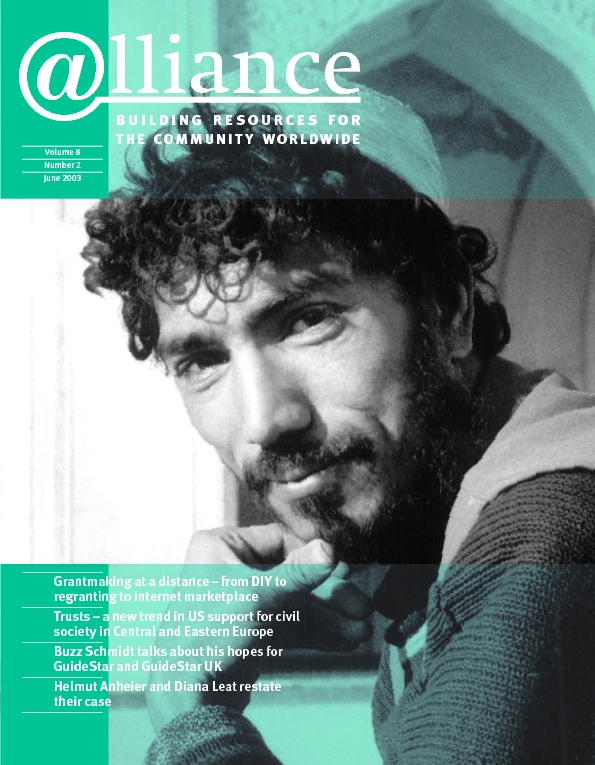Our purpose in writing From Charity to Creativity was to open up a debate on the future of philanthropy. We feel that Rodney Hedley’s review in the last issue of Alliance[1] unfortunately got this debate off to the wrong start. Were it not for his accurate summary of Lord Smith’s foreword, we would wonder whether he had in fact been reading some other book.
Our aim was not to criticize foundations for criticism’s sake. We have both worked on and in philanthropic organizations for many years and are deeply committed to the future of philanthropy. We therefore appreciate the opportunity to restate the main thrust of our argument, which we feel bears little resemblance to what Rodney Hedley thinks we wrote.
Specifically, we argue that the endowed philanthropic foundation is a vitally important institution of modern society. Yet their current visions, roles and practices make it difficult for them to fulfil their promise and the gap between possibility and reality is widening. In response, we propose development of modern, 21st century visions and models for foundations based on their true potential: innovation and creativity.
We need to look anew at foundations from ‘outside the box’. The last fundamental innovation in philanthropy occurred nearly a century ago with the emergence of large-scale grantmaking foundations and the shift from charity, ie almsgiving, to philanthropy, ie addressing root causes. Since then, innovations have primarily been about the form, technique and management of foundations and their endowments, rarely extending to the wider objectives and actual impact of philanthropic institutions.
We question whether philanthropy in its current form will be able to root out the causes of the many social, cultural and political problems afflicting the modern world. Three crucial questions are increasingly being recognized: why is philanthropy, despite clear successes, not having greater impact? Why should philanthropy be limited to a nearly 100-year-old conventional form, the grantmaking foundation? Could it be that the world around philanthropy has changed more than philanthropy itself?
The idea that more philanthropic resources are needed often prevents such questions being posed. The basic problem of modern societies is not primarily a lack of resources; it is a lack of innovation, creative ideas and new thinking. We propose a new model and role for foundations in the modern world, the creative foundation, and flesh out the idea of what we think they should or could look like.
Some sections of the book are indeed ‘thin on data’, as Hedley rightly points out, but, alas, this is one of our key points! We make a strong case for more and better information on what foundations are, do and achieve. In the interest of initiating a debate, we sometimes had to make more assumptions and be more speculative than we would normally wish to do, but the speculative nature of our arguments was made abundantly clear.
However, the supposedly absent discussion of Pharoah and Vincent’s pioneering study on the grantmaking patterns of UK foundations is on pages 104–108, and we make good use of their study at various other points. It is true that we do not discuss the growth of company-sponsored foundations. As far as we know there are no data on such foundations – as distinct from corporate giving programmes. The book focuses on private endowed foundations, whose characteristics underpin the thrust of our argument. Hedley’s quotes are his own ‘flipchartese’, not ours.
Contrary to Hedley, we argue that foundations can win, by doing what only they – free of constituents and customers – can do: encouraging truly creative thinking and working, and challenging existing ‘conventional wisdoms’. Being creative, we argue, involves working across professional and disciplinary boundaries, and resisting capture by the agenda of government, parts of the established voluntary sector, and the easy blandishments of professional fundraisers.
This sort of creative thinking and working might indeed include creating endowed foundations in other countries, as mentioned by Hedley. Part of the issue is, as he implies, about fashion, but we argue that creative foundations can move beyond fashion labels, old or new, taking ideas from past, present and future to construct new approaches and solutions to old and new problems.
Helmut K Anheier and Diana Leat
1 See Alliance, Vol 8, No 1, June 2000, p42.
Helmut K Anheier is Director, Centre for Civil Society, University of California, Los Angeles, and Centennial Professor of Social Policy at the London School of Economics. He can be contacted at anheier@sppsr.ucla.edu
Diana Leat is a freelance consultant. She can be contacted at dianaleat@hotmail.com


Comments (0)